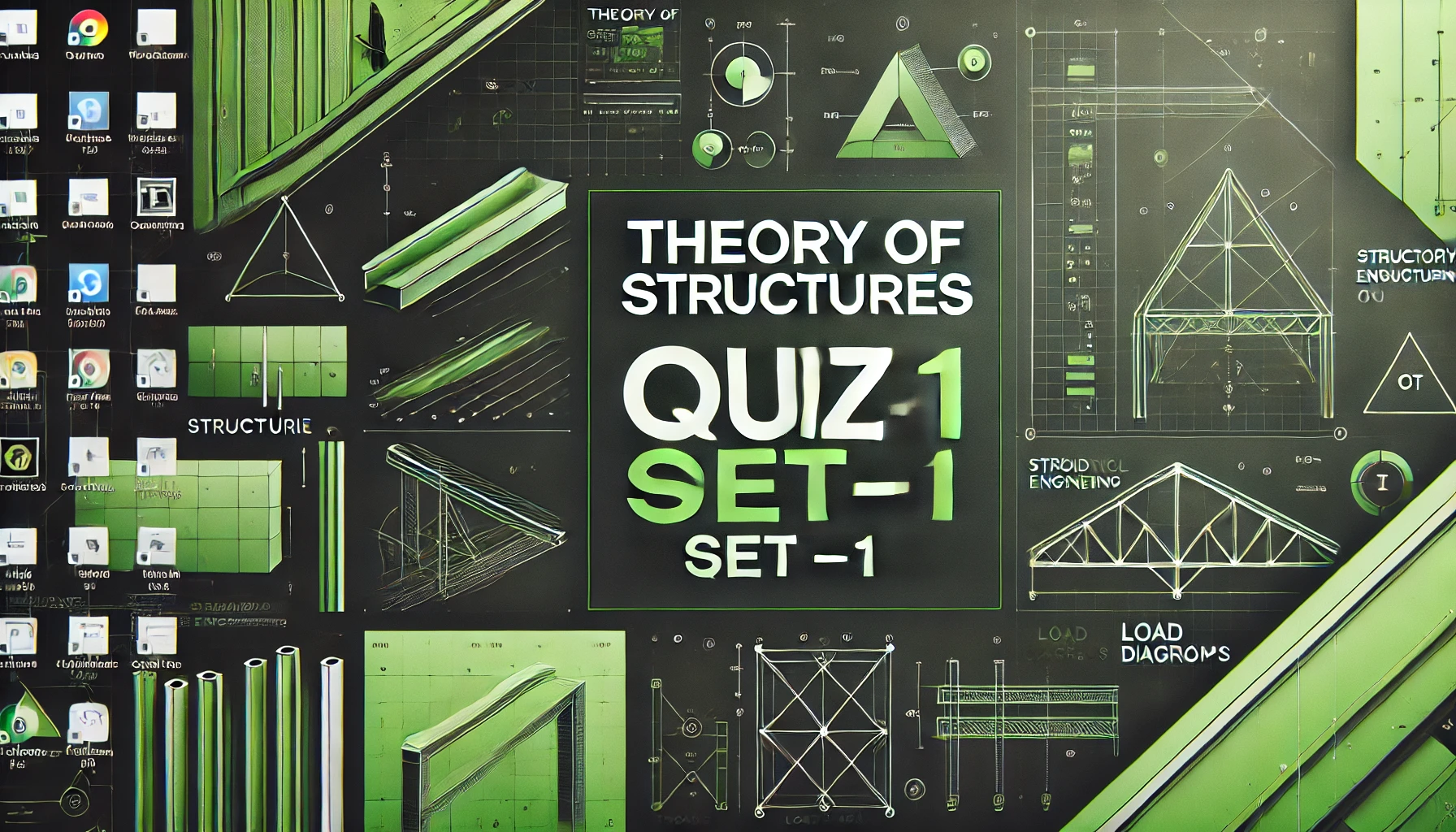Theory of Structures Quiz Set-1
Welcome to “Theory of Structures Quiz Set-1 [2025]”! In this blog, we’ve curated 50+ thought-provoking multiple-choice questions covering the fundamental and advanced concepts of the theory of structures. “Theory of Structures Quiz Set-1 [2025]” is designed to help you refresh your basics, challenge your knowledge, and gain practical insights into the analysis and behavior of structural systems. Whether you’re a civil engineering student, a structural engineering professional, or preparing for competitive exams, this quiz is the perfect way to enhance your expertise in the theory of structures. Let’s dive into the “Theory of Structures Quiz Set-1 [2025]” and start exploring! Theory of Structures: The Theory of Structures is a cornerstone of civil engineering, playing a crucial role in the design, analysis, and construction of structures. From bridges and buildings to towers and dams, understanding the behavior of structures under various loads is essential to ensure their safety, functionality, and durability. In this blog, we will explore the fundamental principles, methods, and applications of the Theory of Structures, highlighting its significance in the field of engineering. What is the Theory of Structures? The Theory of Structures is a branch of engineering that focuses on analyzing and predicting how structures respond to various forces, such as loads, stresses, and environmental conditions. It ensures that structures are stable, strong, and capable of withstanding the forces they are subjected to during their lifecycle. Principles of the Theory of Structures Equilibrium: A structure must be in a state of equilibrium, meaning all forces and moments acting on it must balance out. This principle is governed by Newton’s laws of motion. Compatibility: Deformations in a structure must be consistent with its boundary conditions and constraints. Ensures that no part of the structure experiences unintended displacements or distortions. Stress-Strain Relationship: Describes how materials deform under applied forces. Governed by Hooke’s Law for elastic materials and extended to plastic behavior for other cases. Load Distribution: Loads must be properly distributed to prevent localized stress concentrations that can lead to failure. Types of Structures Rigid Structures: Structures that do not deform significantly under load, such as steel frames and reinforced concrete. Flexible Structures: Structures that allow for significant deformation, like suspension bridges and cables. Static Structures: Structures that remain stationary under load, such as buildings and towers. Dynamic Structures: Structures designed to accommodate movement, such as moving bridges and earthquake-resistant buildings. Methods of Structural Analysis Analytical Methods: Use mathematical equations to calculate forces, moments, and deformations. Examples include the method of joints, method of sections, and moment distribution method. Graphical Methods: Use diagrams and graphical representations to analyze structures. Examples include force diagrams and bending moment diagrams. Numerical Methods: Use computational techniques to solve complex structural problems. Finite Element Method (FEM) is a popular numerical approach. Experimental Methods: Use physical models and tests to study structural behavior. Commonly used for large or unique structures. Common Structural Elements Beams: Horizontal members that resist bending and shear forces. Used in floors, roofs, and bridges. Columns: Vertical members that resist compressive forces. Provide support to beams and slabs. Trusses: Frameworks of interconnected members that resist axial forces. Common in bridges and roofs. Slabs: Flat, horizontal surfaces that distribute loads. Used in floors and roofs. Arches: Curved members that primarily resist compressive forces. Found in bridges, doors, and windows. Applications of the Theory of Structures Building Design: Ensures that residential, commercial, and industrial buildings are safe and functional. Bridge Engineering: Helps design bridges to withstand traffic loads, wind, and environmental factors. Tower Construction: Ensures stability and strength in tall structures like transmission towers and skyscrapers. Earthquake Engineering: Designs structures to resist seismic forces and minimize damage during earthquakes. Dams and Reservoirs: Ensures the stability of water-retaining structures under hydrostatic and hydrodynamic forces. Challenges in Structural Engineering Material Limitations: Materials like concrete and steel have specific limitations in strength and durability. Dynamic Loads: Structures must withstand varying loads, such as wind, earthquakes, and moving vehicles. Environmental Factors: Corrosion, temperature changes, and weathering can affect structural performance. Complex Designs: Modern architectural trends demand innovative and complex structural designs. Modern Advancements in Structural Engineering Finite Element Analysis (FEA): Allows engineers to model and analyze complex structures with high accuracy. Smart Materials: Materials that adapt to changing conditions, such as shape-memory alloys and self-healing concrete. Building Information Modeling (BIM): Integrates structural design with 3D modeling and project management tools. Sustainable Design: Focuses on eco-friendly materials and energy-efficient structures. Advanced Construction Techniques: Includes prefabrication, modular construction, and 3D printing of structural components.
